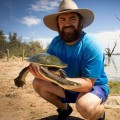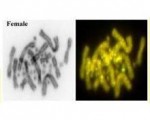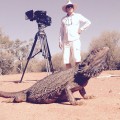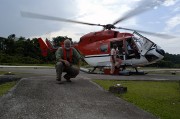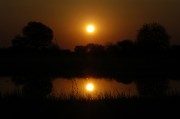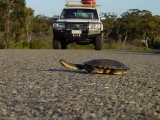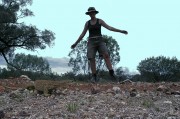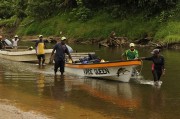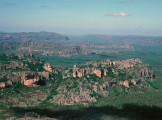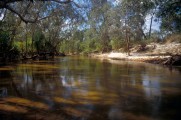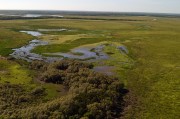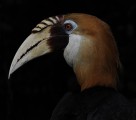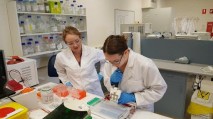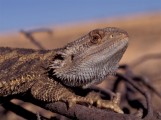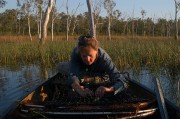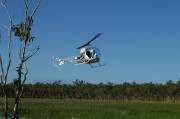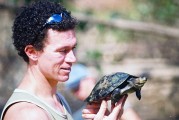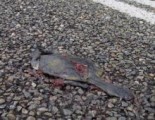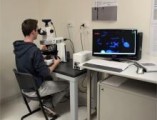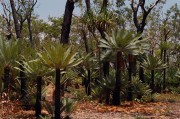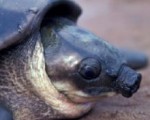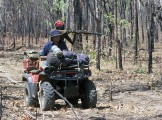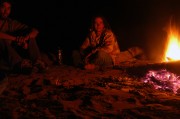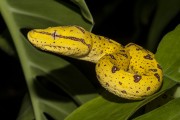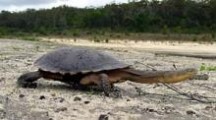 Taxonomy in paelontology and the taxonomy of living forms are from different worlds. The
two disciplines work under fundamentally different constraints. In zoology, species are natural units defined on reproductive barriers to gene flow, notwithstanding operational challenges for their delineation. In palaeontology, addition of the time factor admits boundaries that are subjective and more or less arbitrary, and in any case different from the
delimitation in zoology. Paleontologists have to consider the concept of chronospecies, taxa on the same evolutionary lineage, but separated by time and the accumulation of some morphological change. That is not to say that species delimitation of living forms needs to disregard time, but it is in the form of phylogenetic history of the extant lineage and those closely related to it. The exercise is largely constrained to a snapshot in time, the present.
Taxonomy in paelontology and the taxonomy of living forms are from different worlds. The
two disciplines work under fundamentally different constraints. In zoology, species are natural units defined on reproductive barriers to gene flow, notwithstanding operational challenges for their delineation. In palaeontology, addition of the time factor admits boundaries that are subjective and more or less arbitrary, and in any case different from the
delimitation in zoology. Paleontologists have to consider the concept of chronospecies, taxa on the same evolutionary lineage, but separated by time and the accumulation of some morphological change. That is not to say that species delimitation of living forms needs to disregard time, but it is in the form of phylogenetic history of the extant lineage and those closely related to it. The exercise is largely constrained to a snapshot in time, the present.
The two perspectives come together when considering species delineation of very young fossils and sub-fossils.
In this context, there is a debate running at the moment as to whether the Riverleigh fossil referred to Elseya lavarackorum (White and Archer 1994), a mere 23.9 thousand years old, is alive and well in the Australian gulf country [Photo: Alistair Freeman]
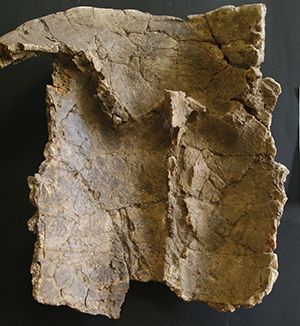 In 1997, Scott Thomson and his colleagues re-evaluated the fossil and reassigned it to the genus Elseya (it was considered an Emydura in the initial description). They went further in assigning extant populations of an as then undescribed form of Elseya, the gulf snapping turtle, to the fossil holotype. Genetic analyses had established the gulf snapping turtle as a distinct species with affinities to the Queensland clade of Elseya (now E. lavarackorum, E. irwini, E. albagula, subgenus Pelocomastes). They observed that the fossil specimen did not differ in any substantial character states from the extant populations of the gulf snapping turtle and noted the young age of the fossil (est. late Pleistocene, ca 23,900 years BP), much younger even than some human fossil remains found in the south of Australia. So Elseya lavarackorum, the gulf snapping turtle, was in a sense a living fossil.
In 1997, Scott Thomson and his colleagues re-evaluated the fossil and reassigned it to the genus Elseya (it was considered an Emydura in the initial description). They went further in assigning extant populations of an as then undescribed form of Elseya, the gulf snapping turtle, to the fossil holotype. Genetic analyses had established the gulf snapping turtle as a distinct species with affinities to the Queensland clade of Elseya (now E. lavarackorum, E. irwini, E. albagula, subgenus Pelocomastes). They observed that the fossil specimen did not differ in any substantial character states from the extant populations of the gulf snapping turtle and noted the young age of the fossil (est. late Pleistocene, ca 23,900 years BP), much younger even than some human fossil remains found in the south of Australia. So Elseya lavarackorum, the gulf snapping turtle, was in a sense a living fossil.
In two recent papers, Joseph-Ouni et al. (2020, 2022) revisited the assignment of Elseya lavarackorum to the Queensland clade of Elseya (subgenus Pelocomastes). They also revisited the proposition that the fossil and extant Elseya lavarackorum belonged to the same species. Unfortunately, these authors initially mounted their challenge in a publication promulgated outside the normal channels of scientific discourse (via The Turtle and Tortoise Preservation Group). This is a somewhat prevocative action given the sensitivities surrounding the proliferation of species descriptions that bypass the cross-checks of the time-honoured process of formally contributing to the scientific record. A second publication, elaborating on the first, was in the Memoirs of the Queensland Museum.
That is all by-the-by. The gist of the contribution of Joseph-Ouni and his colleages to the debate is that they made a case that the chelid turtle fossils found in the deposit with Elseya lavarackorum represent two species, Elseya (Elseya) lavarackorum (White and Archer, 1994) and a newly described Elseya (Pelocomastes) oneiros, the former extinct and the latter comprising a new species that includes the extant gulf snapping turtle and a second Riversleigh fossil.
These studies of Joseph-Ouni et al. are challenged by the recently published views of Thomson et al. (Vertebrate Zoology 2023). Together, the series of papers serve to highlight the difficulties inherent in recognizing and accommodating intraspecific diversity in the fossil record. In particular, to demonstrate that the extant gulf snapping turtle and the historical population to which the fossil Elseya lavarackorum belongs are different species, one must either demonstrate that the two are on independent evolutionary trajectories or, if they are on the same evolutionary trajectory, that the two have diverged sufficiently to be considered different chronospecies.
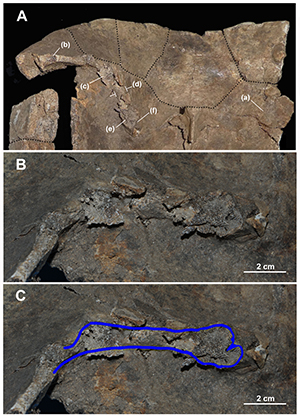 The key element of Thomson et al. in the 2023 paper is that Joseph-Uoni et al. have not convincingly done either. The young age of the fossil Elseya lavarackorum (23.9 kya), demonstration that the fossil and the extant gulf snapping turtle fall within the same clade (Pelocomastes), and the absence of any clear differences between the two in characters of demonstrated taxonomic value, argue strongly for retention of the status quo -- Elseya (Pelocomastes) lavarackorum is the name that should apply to the extant gulf snapping turtle.
The key element of Thomson et al. in the 2023 paper is that Joseph-Uoni et al. have not convincingly done either. The young age of the fossil Elseya lavarackorum (23.9 kya), demonstration that the fossil and the extant gulf snapping turtle fall within the same clade (Pelocomastes), and the absence of any clear differences between the two in characters of demonstrated taxonomic value, argue strongly for retention of the status quo -- Elseya (Pelocomastes) lavarackorum is the name that should apply to the extant gulf snapping turtle.
In making a judgement one way or the other, it is important to note a well-established process of viewing conspecificity as the null proposition, to be challenged or otherwise by the publication of defensible evidence and analysis that refutes that null proposition. The onus is on others to demonstrate (as with Bertrand Russell's teapot) that the two represent distinct species. The view of Thomson et al., expressed in their recent paper, is that Joseph-Ouni et al. have not done this. You should read the paper for details of why Thomson et al. 2023 hold this view.
The gulf snapping turtle is a living fossil that, in these latest machinations, would make Lazarus of Bethany proud.
Disclaimer: I declare a conflict of interest in this debate, having been a co-author of the recent paper by Thomson et al. 2023.
Arthur Georges
